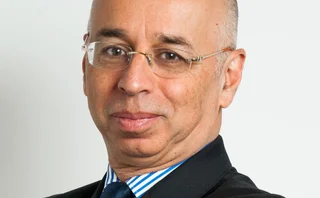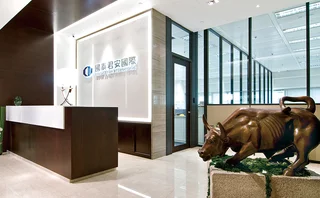
King of junk
This is the story of a man who transformed a minor league investmentbank into a firm capable of taking on – and beating – the giants of Wall Street.He is widely acknowledged as one of the great financiers of his era.But his win-at-all-costs attitude landed him in jail. Philip Moore reports

Perhaps the most influential and decisive meeting in the history of the high-yield bond market took place almost exactly 20 years ago. It was a meeting that, arguably, would change the face of the US – and global – capital market for good. It was a meeting that would shake up the US investment banking community. And it was a meeting that would ultimately put corporate America on notice that sloppy or idle management teams, happy to drift through life without maximizing returns for their shareholders, would henceforth be in danger of living on borrowed time.
The meeting in question took place not around the famed X-shaped trading desk at Drexel Burnham’s six-storey building at Century City in California, nerve center of the high-yield franchise, which by now was transforming Drexel from an obscure fringe player into a formidable Wall Street front-liner. The venue for this three-day meeting, which brought together members of the Drexel Burnham corporate finance team in November 1983, was one of Beverly Hills’ most famous hotels, the Beverly Wilshire Hotel. Predictably enough, that made it much closer to home for the head of Drexel’s corporate bond department, Michael Milken, than for its New York-based head of corporate finance, Fred Joseph, the affable Bostonian who had joined the firm in 1974.
The agenda for these two key protagonists was clear enough. By the early 1980s, Drexel’s influence on the fast-growing market for high-yield debt, aka ‘junk’, was sizeable – worthy of a three-day summit. In 1982, the firm had underwritten some 25% of all new junk issuance in the US market, although the name of Michael Milken had been front page material long before then.
The son of a California accountant, Milken graduated summa cum laude from the University of Berkeley in 1968, before moving on to Wharton Business School, where he wrote a thesis on the value embedded in bonds issued by companies that had fallen from grace. It was during his time at Wharton that he joined the Philadelphia office of the firm that would later become Drexel Burnham as a part-time computer analyst. Two years later he was head of Drexel’s fixed-income research department, energetically promoting his theories on sub-investment grade debt and a good deal else, such as the benefits of individuals investing in professionally managed and broadly diversified funds.
In March 1975, Milken made one of his many appearances on the front pages of US newspapers. Then, a piece in The Wall Street Journal was entitled “One Man’s Junk is another’s Bonanza in the Bond Market” and carried a subtitle explaining that “a bond at $1000 frightens Mr Milken; so he waits to buy at half the price.” Already, the Journal was referring to Milken in the same piece as the “undisputed King of the junk bond market.”
At this stage, Drexel’s interest in high-yielding securities appeared to be confined largely to the secondary market, with one analyst highlighting April 1977, and the $30 million 20-year debenture issue for Texas International, rated single-B and priced with a coupon of 11½%, as Drexel’s first foray into the primary arena. By then, Drexel had already promoted what The Wall Street Journal had described in January 1977 as “the rarest of investment company breeds, a junk bond mutual fund.” That fund advanced the notion of spreading risk in the high-yield market – a notion that would become the cornerstone of the Milken philosophy. The fund allowed investors to dilute the effect of exposure to companies such as WT Grant & Co, the retailer which, to the shock of the nation, had collapsed into bankruptcy the previous year.
It was early in 1978, however, that the magnitude of Milken’s influence within his own firm was becoming strikingly apparent. In January of that year, he gave a rare interview to The New York Times in a profile which explained that Drexel was planning to move “both Mohamed and the mountain” by relocating its 20-strong corporate bond department to California. “He makes so much money for his company that Drexel...is preparing to move its entire bond department from New York to Los Angeles,” the Times reported, “mainly because Mr Milken, a native Californian, would like his two children to have a ‘home and a backyard where they can play every single day without worrying about what the weather is going to be like.’ ”
Driven
Former colleagues say that this concern with his family’s wellbeing was entirely in keeping with the character of an individual described by the Times in 1978 as being “a soft-spoken workaholic whose idea of a big weekend is plowing through a pile of balance sheets.” But one says that the move to California was motivated as much by Milken’s obsessive urge to squeeze every possible hour out of the working day. Moving to California, this former associate says, allowed Milken to start the working day at the same time as New York, and yet have three hours extra at the end of the day. And it is well known that Drexel’s switchboard at Century City would open at 4.45am, with its corporate bond supremo frequently scheduling breakfast meetings as early as 4.00am. A cross-legged Milken would reportedly preside over those meetings, offering attendees weird and wonderful health food long before the stuff became fashionable.
By November 1983, when the Drexel corporate finance team assembled at the Beverly Wilshire for its three-day brainstorming session, what was uppermost in the minds of Joseph and Milken was how their firm could use its expertise in junk bonds to give it a more lasting foothold in the lucrative M&A world then dominated by firms such as Morgan Stanley, Goldman Sachs and First Boston. One option, the attendees concluded, would be for Drexel to use the growing army of investors that it had cultivated through underwriting high-yield bonds to provide the ammunition for primary bond issuance supporting hostile takeover bids.
Milken’s department swung into action more or less immediately, although it was not until 1985 that Drexel demonstrated just how powerful a corporate financing tool high-yield debt could be. That was the year when junk bonds underwritten and placed by Drexel – which also acted as a secondary market-maker for the paper – helped to fund audacious hostile bids such as the takeover of National Can by a relative minnow in terms of sales. Later that same year, $660 million of junk underwritten by Drexel also formed the cornerstone of Carl Icahn’s $1.2 billion purchase of TWA.
But it was a transaction launched in between these two deals that was most responsible for making corporate America in general, and Wall Street in particular, sit up and take notice of the magnetism of Milkenomics. Drexel reportedly scooped fees of $60 million for its role in supporting the successful $1.83 billion hostile acquisition of Revlon by Pantry Pride.
Perhaps more importantly, this relative newcomer in the capital market was starting to put many of Wall Street’s proudest and most established heavyweights in the shade. In the battle for Revlon, Morgan Stanley was given the humdrum responsibility of handling the divestiture of Revlon’s assets, the significance of which was not lost on The Wall Street Journal. “That Morgan Stanley would act as handmaiden to Drexel was viewed as a sea-change on Wall Street,” it commented in December 1985.
Little wonder that by the latter part of the 1980s houses such as Morgan Stanley and Merrill Lynch, disgusted at apparently playing second fiddle to the Drexel upstarts in one of the hottest markets at the time, were channeling more and more resources into developing their own high-yield credentials.
Treading on toes
Little wonder too that Drexel was beginning to make enemies aplenty on Wall Street and beyond, not just because its high-yield franchise was fueling a relentless ascent of the league tables. Competitors muttered disapprovingly that Drexel was much too covetous of its clients, lobbying investors not to support other banks’ deals. They also complained that when Drexel underwrote a popular new issue, it tended to retain an unreasonably large slug of the bonds for its own customers.
Meanwhile, the Fed began to express concerns about the extent to which leverage was being used as a corporate financing tool. And in boardrooms throughout the US, management teams discussed with a mixture of fear and loathing the prevalence of practices such as greenmail, whereby target companies in a hostile takeover bid would be forced to avert the takeover by buying up at a premium the shares acquired by the predator. Or the so-called ‘post-acquisition bust-up’ feature, whereby a highly geared acquirer would need to sell parts of the target company in order to pay off the debt accumulated to support the deal in the first place. “Fast-Growing Drexel irritates Many Rivals with its Tough Tactics,” announced a headline in the Journal in June 1986, in a piece that described the firm as being “unpopular, envied and feared.”
By then, the seeds of Drexel’s destruction were already being sown, with news of the Denis Levine insider trading case – at the time the largest in US history – breaking in May 1986. Widely tagged as a “Wall Street Watergate,” this case alleged that Levine, who had joined Drexel from Shearson Lehman early in 1985, had earned in excess of $12 million by using non-public information to trade in the equity of 54 companies. Five months later, the SEC announced that it was launching a wider investigation into a range of alleged securities law violations at Drexel Burnham itself, and by December, Milken was reported to have retained three top criminal lawyers to represent him in the Levine/Boesky imbroglio.
The lengthy SEC investigation into Drexel, Milken and a number of his associates reportedly ate up some 50,000 man hours and culminated, early in September 1988, in a 184-page complaint filed with a New York court. The charges lodged by the SEC, the sheer magnitude of which stunned Wall Street, ranged from insider trading to stock manipulation, reporting violations and falsified accounts.
Much of the SEC case, argued Drexel’s defenders at the time, had been based on information provided by Ivan Boesky, the arbitrageur who had pleaded guilty to insider trading charges in November 1986. That information, ran the case for the defense, ought to have been rejected as unsound given that it came from a convicted felon. With the SEC countering that it had plenty of sources other than Boesky upon which to base its case, Drexel’s argument was exposed as a feeble defense. When Milken was forced to resign from Drexel in June 1989, the writing was on the wall for a firm that had by now lost all credibility.
At his trial, Milken entered a plea of guilty to five securities and reporting violations, and was sentenced by Judge Kimba Wood in November 1990 to a 10-year prison sentence, a far stiffer punishment than most had expected for an individual dubbed by his prosecutors as “Wall Street’s Public Enemy Number One.” Importantly, however, as Michael Milken’s official website still reminds its visitors today, none of the violations on which he was sentenced related to insider dealing. “He had no involvement in insider dealing, never pleaded to it, and was never convicted of it,” the website advises.
The same website also insists that the money that the Milken family has channeled into medical research and education over the past three decades – amounting to some $750 million – dwarfs any economic impact of his securities infractions. Certainly, there can be no disputing that since his release from prison in January 1993, Milken has dedicated the lion’s share of his time and fortune to medical research.
Milken’s interest in such work dates back to 1972 when his mother-in-law was diagnosed with breast cancer, and was followed up with initiatives such as the Milken Family Foundation (originally set up in 1982) and, more recently, the prostate cancer foundation (CaP CURE) and the Center for Accelerating Medical Solutions (CAMS). So it was no surprise that when Credit invited Michael Milken to present his own side of the junk bond story, he declined, with his office explaining that “Mike’s focus is advancing medical research. If he accepted every request for an interview, he would have time for nothing else, and, given the importance of his work in advancing medical solutions, he doesn’t feel that’s the best use of his time and energy.”
Fair enough. But as far as the credit market is concerned, what is the Milken legacy and the long-term contribution he has made to the development of the US capital market and economy? To many, who still count themselves as close friends nearly 13 years after his fall from grace, that contribution is incalculable.
It is, for example, now about five years since Harold Simmons last spoke to Milken, but the chairman of Valhi Inc., a Dallas-based holding company with interests ranging from chemicals to waste management, suggests that the former Drexel man would be welcome any time at his summer retreat in Santa Barbara. In the 1980s, Valhi tapped the high-yield market via Drexel three times, raising $90 million, $125 million and $300 million, and when Simmons looks back at his company’s history – which turned over slightly more than $300 million in FY2002 – he is convinced that its growth in the 1980s would have been impossible had it not been for the support of Drexel in general and Milken in particular.
“Drexel and Milken were essential to my business because they helped raise funding for us when no other bank would,” says Simmons. “Our three bond issues helped us to fund a number of successful acquisitions, some of which we have retained to this day.” But Simmons adds that Milken was more than a supportive business associate, remembering him as an approachable, accessible and affable individual who became a family friend and tennis partner. “I was very surprised and disappointed at the trouble he got into, which he probably didn’t deserve,” says Simmons.
This view is not an unusual one. To scores of business leaders and investors, Milken remains a genius who did not just revolutionize the global capital market by championing the merits of sub-investment grade debt as an asset class. More importantly, say his fans, in doing so Milken opened a reservoir of capital to companies that would otherwise have remained market pariahs.
Following the economic decline of the early 1970s, there was no shortage of US companies in this category unable to command the attention of Wall Street’s more conservative investment bankers. By the middle of the decade, of the 500 largest US firms ranked by sales only 208 were rated single-A or better by S&P. The other 292 were generally regarded as perilous credits to be avoided at all costs, which was a patently ludicrous situation.
By extension, the argument runs that Milken fueled economic expansion, created job opportunities, and fostered an entrepreneurial spirit in the US in the 1980s. Milken fans also argue that his innovations prized open a wealth of opportunities for investors, ranging from mutual fund holders to insurance companies and pension funds. And it could be argued that the enhanced returns driven by Milkenomics were not confined to the bond market. By using high-yield bonds as a takeover currency, Milken forced management teams across the US to focus on the delivery of shareholder value, hence helping to support share price multiples.
Anton Simon, the London-based managing director of European high yield at Putnam Investments, who ran US high-yield money at the United Bank of Kuwait (UBK) in the mid-1980s, was one of the first non-US investors to buy American high-yield bonds. To explore the asset class, Simon spent two weeks on Milken’s X-desk, watching and learning. Almost 20 years later, Simon explains that he is blind to none of Milken’s shortcomings; nevertheless, he says that in terms of his influence and innovation, Milken should be ranked alongside Nathan Rothschild and J. P. Morgan as one of the three most important financiers ever.
Others, however, take a very different view. Many argue that the idea that Milken somehow invented the high-yield bond is an absolute myth, and that the instrument had been around for decades and even centuries before he got his knees beneath his famous X-desk. They reckon that for all Milken’s passionately delivered harangues about the rights of minority groups and lesser-rated companies, his chief priority was advancing his own interests.
These detractors also argue that the suggestion that Milken added economic value and was a net creator of jobs is pure hogwash. Sure, a number of successful companies owed their expansion to financing that no bank other than Drexel could or would have raised. But for every company chairman such as Simmons, who can look fondly back on the support of Drexel, there are several who can resentfully recall how their businesses were destroyed, and their workforces traumatized, by hostile asset-strippers funded by Milken.
Those who believe that Milken lost a great deal more for investors than he made, will presumably endorse the views of Robert Walker, director of enforcement at the SEC. When the Milken name was conspicuous by its absence on the list of pardons distributed by outgoing president Clinton at the end of 2000, Walker explained why. “In the Commission’s 67-year history, few people have done more than Milken to undermine public confidence in our market. The scope and magnitude of Milken’s multiple, wilful federal securities law violations make a pardon inappropriate.”
It was a cruel epitaph on the investment banker’s career. A kinder view is that Milken was ultimately made a scapegoat for the excesses that characterized so much of Wall Street during the late 1980s. This view was strengthened some years later by SEC chairman Arthur Levitt when, in November 1997, he conceded that “the SEC was asleep at the wheel during the rise of the junk bond era, and only after much damage was done to many businesses and society [did the SEC] do its duty to rein in irresponsible people and their corporations.”
Perhaps the most balanced, accurate and enduring commentary on the Milken legacy came from The New York Times in May 1990, which observed that in the high-yield market Milken developed a “lifeline of credit for hundreds of emerging companies.” Although there was no condoning Milken’s criminality, the paper added: “If overzealous Government regulators overreact by indiscriminately dismantling his junk bond legacy, they will wind up crushing the most dynamic part of the economy.”
Thirteen years later, and with the global high-yield market now worth more than $1 trillion, it is self-evident that the Milken legacy has been anything but dismantled.
Only users who have a paid subscription or are part of a corporate subscription are able to print or copy content.
To access these options, along with all other subscription benefits, please contact info@risk.net or view our subscription options here: http://subscriptions.risk.net/subscribe
You are currently unable to print this content. Please contact info@risk.net to find out more.
You are currently unable to copy this content. Please contact info@risk.net to find out more.
Copyright Infopro Digital Limited. All rights reserved.
You may share this content using our article tools. Printing this content is for the sole use of the Authorised User (named subscriber), as outlined in our terms and conditions - https://www.infopro-insight.com/terms-conditions/insight-subscriptions/
If you would like to purchase additional rights please email info@risk.net
Copyright Infopro Digital Limited. All rights reserved.
You may share this content using our article tools. Copying this content is for the sole use of the Authorised User (named subscriber), as outlined in our terms and conditions - https://www.infopro-insight.com/terms-conditions/insight-subscriptions/
If you would like to purchase additional rights please email info@risk.net
More on Structured products
A guide to home equity investments: the untapped real estate asset class
This report covers the investment opportunity in untapped home equity and the growth of HEIs, and outlines why the current macroeconomic environment presents a unique inflection point for credit-oriented investors to invest in HEIs
Podcast: Claudio Albanese on how bad models survive
Darwin’s theory of natural selection could help quants detect flawed models and strategies
Range accruals under spotlight as Taiwan prepares for FRTB
Taiwanese banks review viability of products offering options on long-dated rates
Structured products gain favour among Chinese enterprises
The Chinese government’s flagship national strategy for the advancement of regional connectivity – the Belt and Road Initiative – continues to encourage the outward expansion of Chinese state-owned enterprises (SOEs). Here, Guotai Junan International…
Structured notes – Transforming risk into opportunities
Global markets have experienced a period of extreme volatility in response to acute concerns over the economic impact of the Covid‑19 pandemic. Numerix explores what this means for traders, issuers, risk managers and investors as the structured products…
Structured products – Transforming risk into opportunities
The structured product market is one of the most dynamic and complex of all, offering a multitude of benefits to investors. But increased regulation, intense competition and heightened volatility have become the new normal in financial markets, creating…
Increased adoption and innovation are driving the structured products market
To help better understand the challenges and opportunities a range of firms face when operating in this business, the current trends and future of structured products, and how the digital evolution is impacting the market, Numerix’s Ilja Faerman, senior…
Structured products – The ART of risk transfer
Exploring the risk thrown up by autocallables has created a new family of structured products, offering diversification to investors while allowing their manufacturers room to extend their portfolios, writes Manvir Nijhar, co-head of equities and equity…







